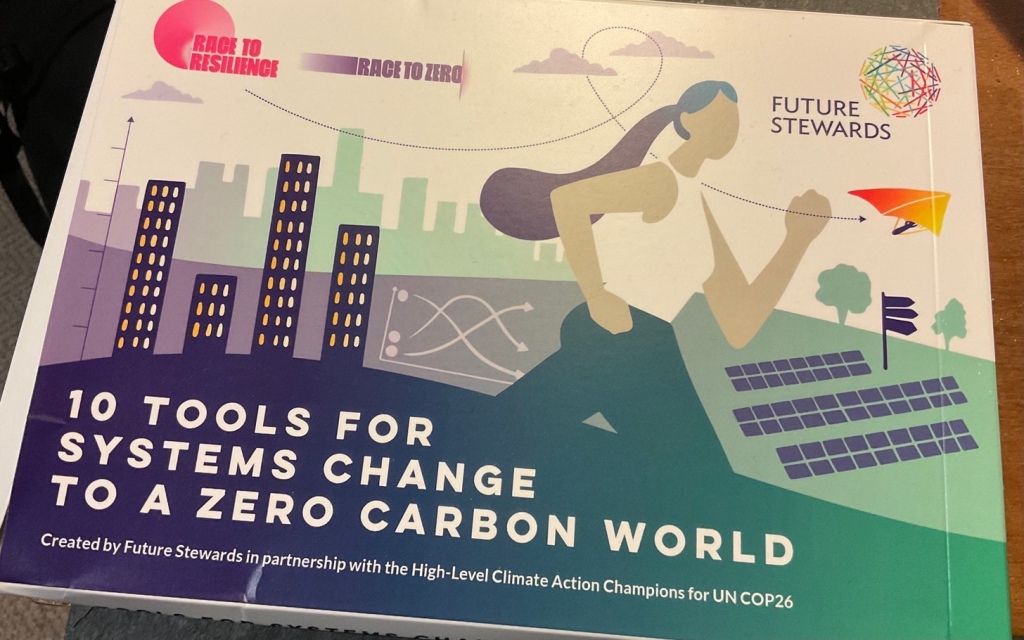
Future Stewards is a small organisation dedicated to training people in using systems thinking to help us get to a regenerative future. The usual disclosure: SOIF, where I mostly work, is a partner organisation in their Three Horizons Practice Network.
One of the tools they’ve produced to help in this, as part of some work with the High Level Climate Action Champtions for COP26, is a set of 10 cards about tools that people can use to think about systems change. These have now been published online as a pdf.
A set of prompts
It’s not a user manual—you’d have to familiarise yourself with the underlying methods—but it’s certainly a useful set of prompts. They’re built around three ‘simple rules’ or guiding principles that can accelerate change:
- Harness ambition loops
- Set exponential goals (which is about looking for ways to move technologies and applications rapidly along an S-curve)
- Follow shared action pathways.
A quick tour
A quick tour of the 10 cards, with links where I have them.
The first one, Working with the future, has a useful 2×2 schematic of the type of approaches you need to thinking about the future for different combinations of agency and uncertainty.
The second one is Three Horizons, which I was involved in developing, and is, in effect, a visual mapping tool to understand patterns of systems change against preferable or possible futures.
The third one, A Regenerative Worldview, draws on Bill Reed’s spiral that maps more or less effective uses of energy against collaborating with natural systems or fragmenting them. The first of pair is good; the second of each is bad.
Models of change
Fourth is systems mapping—just making sure you can represent the system you’re dealing with; fifth is ‘Accelerating Transitions Framework, effectively looking for ways to accelerate positive change up an S-curve. This proposes a three part model of change:
emergence, diffusion and reconfiguration. At each stage, different policies, and different kinds of international co-operation, are likely to be effective and accelerating the transition.
Related to this are causal loops (six), specifically looking for interventions that are ‘self-propelling’ or ‘self-amplifying’, and ‘Exponential goals’ (seven) where increasing take-up of a climate friendly technology can create rapid diffusion, through economies of scale and economies of scope, which combine to reduce costs rapidly.
Tipping points and cascades
Eight is about looking for tipping points and cascades:
A tipping point is a place where a small intervention can trigger a large response, sending a system into a qualitatively different future state. In transitions, tipping points can exist where a new solution becomes more affordable, accessible, profitable, attractive, socially acceptable, or higher performing than old solutions.
Cascades follow when a critical mass of actors has adopted a new approach or a new practice.
Nine is about building ‘ambition loops’. Effectively these are models of change that contain within them a virtuous circle that reinforces change.
Flywheels and positive change
Some readers, incidentally, might recognise this as a version of Jim Collins’ ‘flywheel’. Although this tends to be associated with Amazon, definitely a business that is at the wrong end of the regenerative worldview, there’s no reason why the concept can’t serve progressive change. I used it for a model of change to improve urban food environments (pdf, page 31) in some client work last year.
And the last one is about the power of convening: the need to bring stakeholders together around change to understand their objectives and their sticking points, and to look for solutions that get beyond mere trade-offs. This reminds me of the Future Search injunction to ‘get the whole system in the room’.
Each card comes with the model on one side and a zero climate example on the other side. They were compiled by my sometime colleague Bill Sharpe, who uses much of this thinking in his day-to-day thinking.